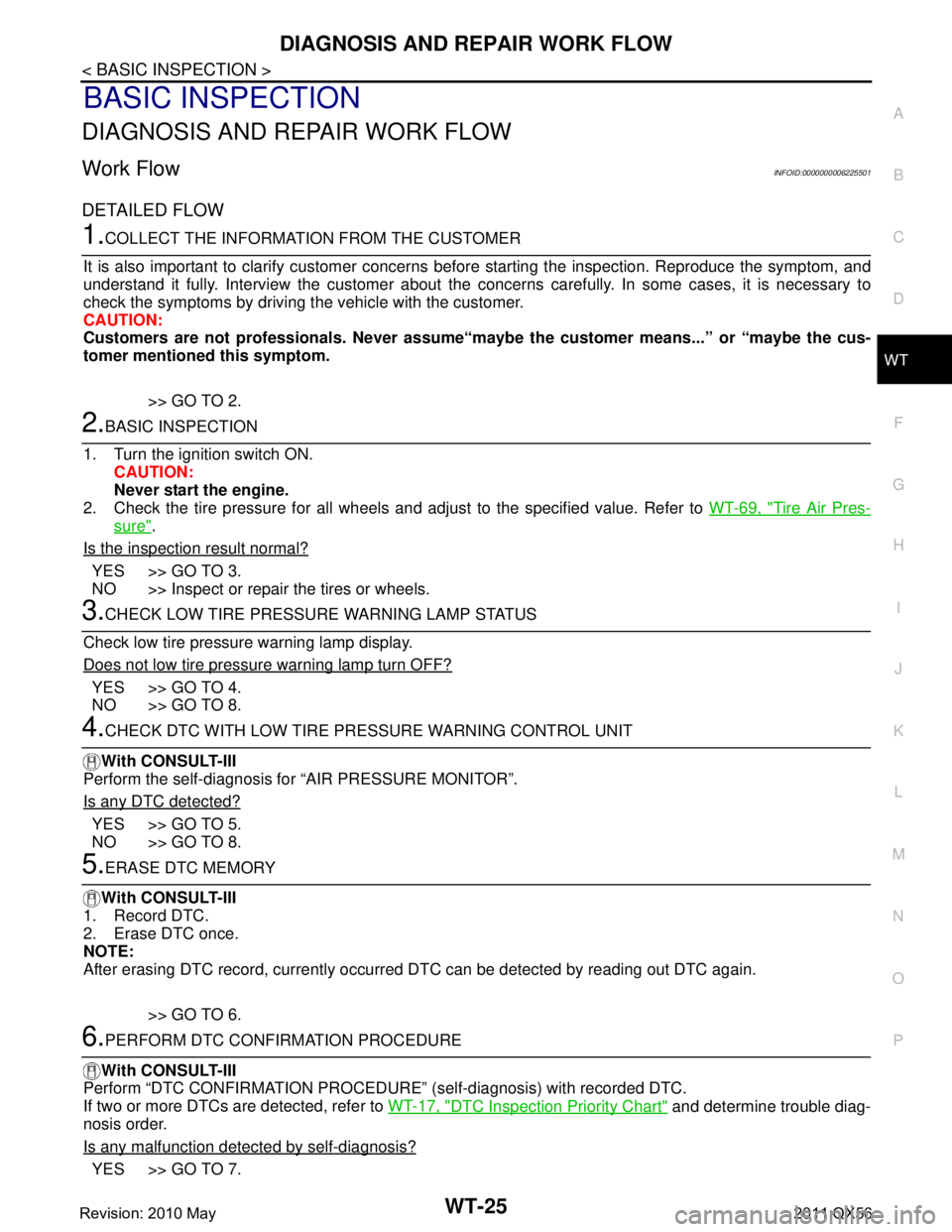2011 INFINITI QX56 tires
[x] Cancel search: tiresPage 5180 of 5598
![INFINITI QX56 2011 Factory Service Manual
TM-92
< BASIC INSPECTION >[7AT: RE7R01B]
ADDITIONAL SERVICE WHEN RE
PLACING CONTROL VALVE & TCM
ADDITIONAL SERVICE WHEN REPLACING CONTROL VALVE & TCM
DescriptionINFOID:0000000006233274
Decel G sensor INFINITI QX56 2011 Factory Service Manual
TM-92
< BASIC INSPECTION >[7AT: RE7R01B]
ADDITIONAL SERVICE WHEN RE
PLACING CONTROL VALVE & TCM
ADDITIONAL SERVICE WHEN REPLACING CONTROL VALVE & TCM
DescriptionINFOID:0000000006233274
Decel G sensor](/manual-img/42/57033/w960_57033-5179.png)
TM-92
< BASIC INSPECTION >[7AT: RE7R01B]
ADDITIONAL SERVICE WHEN RE
PLACING CONTROL VALVE & TCM
ADDITIONAL SERVICE WHEN REPLACING CONTROL VALVE & TCM
DescriptionINFOID:0000000006233274
Decel G sensor calibration must be performed when replacing control valve & TCM.
Special Repair RequirementINFOID:0000000006233275
1.PREPARATION BEFORE CALIBRATION PROCEDURE
1. Park the vehicle on a flat road.
2. Adjust pressure in all tires to the specified value. Refer to WT-69, "
Tire Air Pressure".
>> GO TO 2.
2.PERFORM CALIBRATION
With CONSULT-III
1. Turn ignition switch ON.
CAUTION:
Never start the engine.
2. Select “G SENSOR CALIBRATION” in “Work Support” in “TRANSMISSION”.
3. Touch “START”. CAUTION:
Never give any motion to the vehicle during the calibration.
Is
“completed” displayed?
YES >> GO TO 3.
NO >> Perform the calibration again.
3.CHECK DTC
With CONSULT-III
1. Turn ignition switch OFF and wait 10 seconds or more.
2. Turn ignition switch ON.
3. Select “Self Diagnostic Results” in “ABS”.
Is
“C1145” or “C1146” detected?
YES >> Refer to BRC-51, "DTC Index".
NO >> Calibration end.
Revision: 2010 May2011 QX56
Page 5181 of 5598
![INFINITI QX56 2011 Factory Service Manual
CALIBRATION OF DECEL G SENSORTM-93
< BASIC INSPECTION > [7AT: RE7R01B]
C
EF
G H
I
J
K L
M A
B
TM
N
O P
CALIBRATION OF DECEL G SENSOR
DescriptionINFOID:0000000006233272
Decel G sensor calibration must INFINITI QX56 2011 Factory Service Manual
CALIBRATION OF DECEL G SENSORTM-93
< BASIC INSPECTION > [7AT: RE7R01B]
C
EF
G H
I
J
K L
M A
B
TM
N
O P
CALIBRATION OF DECEL G SENSOR
DescriptionINFOID:0000000006233272
Decel G sensor calibration must](/manual-img/42/57033/w960_57033-5180.png)
CALIBRATION OF DECEL G SENSORTM-93
< BASIC INSPECTION > [7AT: RE7R01B]
C
EF
G H
I
J
K L
M A
B
TM
N
O P
CALIBRATION OF DECEL G SENSOR
DescriptionINFOID:0000000006233272
Decel G sensor calibration must be performed when the following operation is performed.
Removal and installation or replacem ent of yaw rate/side/decel G sensor
Replacement of A/T assembly
Replacement of ABS actuator and electric unit (control unit)
CAUTION:
After removing/replacing the yaw rate/side/decal G sensor or replaci ng the ABS actuator and electric
unit (control unit), the decel G sensor of the ABS act uator and electric unit (control unit) must be cali-
brated first. Refer to BRC-66, "
Description".
Special Repair RequirementINFOID:0000000006233273
CAUTION:
After removing/replacing the yaw rate/side/decal G sensor or replaci ng the ABS actuator and electric
unit (control unit), the decel G sensor of the ABS act uator and electric unit (control unit) must be cali-
brated first. Refer to BRC-66, "
Description".
1.PREPARATION BEFORE CALIBRATION PROCEDURE
1. Park the vehicle on a flat road.
2. Adjust pressure in all tires to the specified value. Refer to WT-69, "
Tire Air Pressure".
>> GO TO 2.
2.PERFORM CALIBRATION
With CONSULT-III
1. Turn ignition switch ON. CAUTION:
Never start the engine.
2. Select “G SENSOR CALIBRATION” in “Work Support” in “TRANSMISSION”.
3. Touch “START”. CAUTION:
Never give any motion to the vehicle during the calibration.
Is
“completed” displayed?
YES >> GO TO 3.
NO >> Perform the calibration again.
3.CHECK DTC
With CONSULT-III
1. Turn ignition switch OFF and wait 10 seconds or more.
2. Turn ignition switch ON.
3. Select “Self Diagnostic Results” in “ABS”.
Is
“C1145” or “C1146” detected?
YES >> Refer to BRC-51, "DTC Index".
NO >> Calibration end.
Revision: 2010 May2011 QX56
Page 5188 of 5598
![INFINITI QX56 2011 Factory Service Manual
TM-100
< BASIC INSPECTION >[7AT: RE7R01B]
STALL TEST
STALL TEST
Inspection and JudgmentINFOID:0000000006226793
INSPECTION
1. Inspect the amount of engine oil. Replenish the engine oil if necessary.
2 INFINITI QX56 2011 Factory Service Manual
TM-100
< BASIC INSPECTION >[7AT: RE7R01B]
STALL TEST
STALL TEST
Inspection and JudgmentINFOID:0000000006226793
INSPECTION
1. Inspect the amount of engine oil. Replenish the engine oil if necessary.
2](/manual-img/42/57033/w960_57033-5187.png)
TM-100
< BASIC INSPECTION >[7AT: RE7R01B]
STALL TEST
STALL TEST
Inspection and JudgmentINFOID:0000000006226793
INSPECTION
1. Inspect the amount of engine oil. Replenish the engine oil if necessary.
2. Drive for about 10 minutes to warm up the vehicle
so that the A/T fluid temperature is 50 to 80°C (122 to
176 °F). Inspect the amount of AT F. Replenish if necessary.
3. Securely engage the parking brake so that the tires do not turn.
4. Start the engine, apply foot brake, and place selector lever in “D” position.
5. Gradually press down the accelerator pedal while holding down the foot brake.
6. Quickly read off the stall speed, and quickly release the accelerator pedal. CAUTION:
Never hold down the accelerator pedal for more than 5 seconds during this test.
7. Shift the selector lever to “N” position.
8. Cool down the ATF. CAUTION:
Run the engine at idle for at least 1 minute.
9. Repeat steps 5 through 8 with selector lever in “R” position.
JUDGMENT OF STALL TEST
O: Stall speed within standard value position
H: Stall speed higher than standard value
L: Stall speed lower than standard value
Stall test standard value position
Stall speed : Refer to TM-297, "Stall Speed".
Selector lever position
Possible location of malfunction
“D” and “M” “R”
Stal l s pe ed HO
Low brake
1st one-way clutch
2nd one-way clutch
OH Reverse brake
1st one-way clutch
2nd one-way clutch
L L Engine and torque converter one-way clutch
H H Line pressure low
Does not shift-up “D” or “M” position 1 → 2 Slipping in 2GR, 3GR, 4GR or 6GR 2346 brake slippage
Does not shift-up “D” or “M” position 2 → 3 Slipping in 3GR, 4GR or 5GR Direct clutch slippage
Does not shift-up “D” or “M” position 3 → 4 Slipping in 4GR, 5GR, 6GR or 7GR High and low reverse clutch slippage
Does not shift-up “D” or “M” position 4 → 5 Slipping in 5GR, 6GR or 7GR Input clutch slippage
Does not shift-up “D” or “M” position 5 → 6 Slipping in 2GR, 3GR, 4GR or 6GR 2346 brake slippage
Does not shift-up “D” or “M” position 6 → 7 Slipping in 7GR Front brake slippage
Revision: 2010 May2011 QX56
Page 5451 of 5598

WT-1
SUSPENSION
C
DF
G H
I
J
K L
M
SECTION WT
A
B
WT
N
O PCONTENTS
ROAD WHEELS & TIRES
PRECAUTION ................ ...............................3
PRECAUTIONS .............................................. .....3
Precaution for Supplemental Restraint System
(SRS) "AIR BAG" and "SEAT BELT PRE-TEN-
SIONER" ............................................................. ......
3
Precaution Necessary for Steering Wheel Rota-
tion after Battery Disconnect .....................................
3
Service Notice or Precautions for TPMS ...................4
Service Notice or Precautions for Road Wheel .........4
PREPARATION ............................................5
PREPARATION .............................................. .....5
Special Service Tools .......................................... ......5
Commercial Service Tools ........................................5
SYSTEM DESCRIPTION ..............................6
COMPONENT PARTS ................................... .....6
Component Parts Location .................................. ......6
Component Description .............................................7
Low Tire Pressure Warning Control Unit ...................7
Transmitter ................................................................7
Tire Pressure Receiver .............................................8
Low Tire Pressure Warning Lamp .............................8
SYSTEM ..............................................................9
System Description ............................................. ......9
Tire Inflation Indicator Function ...............................10
DIAGNOSIS SYSTEM (LOW TIRE PRES-
SURE WARNING CONTROL UNIT) ..................
12
CONSULT-III Function ........................................ ....12
ECU DIAGNOSIS INFORMATION ..............14
LOW TIRE PRESSURE WARNING CON-
TROL UNIT ..................................................... ....
14
Reference Value ................................................. ....14
DTC Inspection Priority Chart .................................17
DTC Index ...............................................................18
WIRING DIAGRAM ......................................19
TIRE PRESSURE MONITORING SYSTEM ......19
Wiring Diagram .................................................... ....19
BASIC INSPECTION ...................................25
DIAGNOSIS AND REPAIR WORK FLOW .......25
Work Flow ............................................................ ....25
ADDITIONAL SERVICE WHEN REPLACING
LOW TIRE PRESSURE WARNING CON-
TROL UNIT ........................................................
27
Description ...............................................................27
Work Procedure .......................................................27
TRANSMITTER WAKE UP OPERATION .........28
Description ...............................................................28
Work Procedure .......................................................28
ID REGISTRATION ...........................................29
Description ...............................................................29
Work Procedure .......................................................29
DTC/CIRCUIT DIAGNOSIS .........................31
C1704, C1705, C1706, C1707 LOW TIRE
PRESSURE .......................................................
31
DTC Logic ............................................................ ....31
Diagnosis Procedure ...............................................31
C1708, C1709, C1710, C1711 TRANSMITTER
(NO DATA) ........................................................
33
DTC Logic ............................................................ ....33
Diagnosis Procedure ...............................................33
C1716, C1717, C1718, C1719 TRANSMITTER
(PRESSURE DATA) ..........................................
37
DTC Logic ............................................................ ....37
Diagnosis Procedure ...............................................37
C1728 RECEIVER ID ........................................39
Revision: 2010 May2011 QX56
Page 5454 of 5598

WT-4
< PRECAUTION >
PRECAUTIONS
5. When the repair work is completed, re-connect both battery cables. With the brake pedal released, turn
the push-button ignition switch from ACC position to ON position, then to LOCK position. (The steering
wheel will lock when the push-button igniti on switch is turned to LOCK position.)
6. Perform self-diagnosis check of all control units using CONSULT-III.
Service Notice or Precautions for TPMSINFOID:0000000006225485
Low tire pressure warning lamp blinks for 1min, then turns ON when occurring any malfunction except low tire pressure. Erase the self-diagnosis memories for low tire pressure warning control unit, or register the ID
to turn low tire pressure warning lamp OFF. For ID registration, refer to WT-29, "
Work Procedure".
ID registration is required when replacing or rotating wheel s, replacing transmitter or low tire pressure warn-
ing control unit. Refer to WT-29, "
Work Procedure".
Replace grommet seal, valve core and cap of transmitter in TPMS, when replacing each tire by reaching the
wear limit. Refer to WT-66, "
Exploded View".
For tire inflation indicator function, refer to the following.
- When inflating the tires, park the vehicle in the safe area and ensure the safety of the working area.
- Read and understand the tire inflation indicator function prior to use.
- Inflate the tires one at a time.
- If there is no response for approximately 15 seconds or mo re after inflating the tires, cancel the use of the
tire inflation indicator function or move the vehicle approximately 1 m (3.2 ft) backward or forward to try
again. The air filler pressure may be weak or out of service area.
- Despite the high-precision TPMS pressure sensor, an i ndicated value may differ from that of the pressure
gauge.
- Air pressure is measured rather high due to the rise in tire air temperature after driving.
- If TPMS is malfunctioning, the tire inflation indicator is unusable.
Service Notice or Precautions for Road WheelINFOID:0000000006225486
Genuine NISSAN aluminum wheel is designed for each type of vehicle. Use it on the specified vehicle only.
Use Genuine NISSAN parts for the wheel nuts.
Always use them after adjusting the wheel balance. For the balance weights, use Genuine NISSAN alumi-
num wheel weights.
Use caution when handling the aluminum wheels, because they can be easily scratched. When removing
dirt, do not use any abrasives, a wire brush, or other it ems that may scratch the coating. Use a neutral deter-
gent if a detergent is needed.
After driving on roads scattered with anti-ici ng salts, wash off the wheels completely.
When installing road wheels onto the vehicle, always wipe of f any dirt or foreign substances to prevent them
from being trapped between the contact surfaces of wheel.
Never apply oil to nut and bolt threads.
Revision: 2010 May2011 QX56
Page 5461 of 5598

SYSTEMWT-11
< SYSTEM DESCRIPTION >
C
DF
G H
I
J
K L
M A
B
WT
N
O P
If there is no response for approximately 15 seconds or mo re after inflating the tires, cancel the use of the
tire inflation indicator function or move the vehicle approximately 1 m (3.2 ft) backward or forward to try
again. The air filler pressure may be weak or out of service area.
Revision: 2010 May2011 QX56
Page 5462 of 5598

WT-12
< SYSTEM DESCRIPTION >
DIAGNOSIS SYSTEM (LOW TIRE PRESSURE WARNING CONTROL UNIT)
DIAGNOSIS SYSTEM (LOW TIRE PRESSURE WARNING CONTROL
UNIT)
CONSULT-III FunctionINFOID:0000000006225496
APPLICATION ITEMS
CONSULT-III performs the following functions in combinat ion of data reception, instruction, and transmission
via communication lines from low tire pressure warning control unit.
*: The following diagnosis information is erased by erasing.
DTC
ECU IDENTIFICATION
Part number of low tire pressure warning control unit is displayed.
SELF DIAGNOSIS RESULTS
Refer to WT-18, "DTC Index".
DATA MONITOR
ACTIVE TEST
NOTE:
After completing the work below, perform an active test.
1. Check ID registration state and perform self-diagnosis.
2. Erase the self-diagnosis result history.
Mode FUNCTION DESCRIPTION
ECU IDENTIFICATION Displays the part number of low tire pressure warning control unit.
SELF-DIAGNOSIS RESULTS Self-diagnosis result can be quickly read.
*
DATA MONITOR Input and output data of low tire pressure warning control unit can be read.
ACTIVE TESTSends command to the low tire pressure warning control unit to change output signals and check
operation of output system.
WORK SUPPORT Components can be quickly and accurately adjusted.
Monitor item (Unit) Remarks
VHCL SPEED SE
[(km/h) or (MPH)] Vehicle speed is displayed.
AIR PRESS FL
[(kPa), (kg/cm
2) or (Psi)] Air pressure of front LH tires is displayed.
AIR PRESS FR
[(kPa), (kg/cm
2) or (Psi)] Air pressure of front RH tires is displayed.
AIR PRESS RR
[(kPa), (kg/cm
2) or (Psi)] Air pressure of rear
RH tires is displayed.
AIR PRESS RL
[(kPa), (kg/cm
2) or (Psi)] Air pressure of rear
LH tires is displayed.
ID REGST FL1 ID registration status of front LH transmitter is displayed.
ID REGST FR1 ID registration status of front RH transmitter is displayed.
ID REGST RR1 ID registration status of rear RH transmitter is displayed.
ID REGST RL1 ID registration status of rear LH transmitter is displayed.
WARNING LAMP Control status of low tire pressure warning lamp is displayed.
BUZZER Control status of buzzer in combination meter by low tire pressure warning con-
trol unit is displayed.
NOTE:
Not use in TPMS, but displayed.
Revision: 2010 May2011 QX56
Page 5475 of 5598

DIAGNOSIS AND REPAIR WORK FLOWWT-25
< BASIC INSPECTION >
C
DF
G H
I
J
K L
M A
B
WT
N
O P
BASIC INSPECTION
DIAGNOSIS AND REPAIR WORK FLOW
Work Flow INFOID:0000000006225501
DETAILED FLOW
1.COLLECT THE INFORMATION FROM THE CUSTOMER
It is also important to clarify customer concerns before starting the inspection. Reproduce the symptom, and
understand it fully. Interview the customer about the concer ns carefully. In some cases, it is necessary to
check the symptoms by driving the vehicle with the customer.
CAUTION:
Customers are not professionals. Never assume“mayb e the customer means...” or “maybe the cus-
tomer mentioned this symptom.
>> GO TO 2.
2.BASIC INSPECTION
1. Turn the ignition switch ON. CAUTION:
Never start the engine.
2. Check the tire pressure for all wheels and adjust to the specified value. Refer to WT-69, "
Tire Air Pres-
sure".
Is the inspection result normal?
YES >> GO TO 3.
NO >> Inspect or repair the tires or wheels.
3.CHECK LOW TIRE PRESSURE WARNING LAMP STATUS
Check low tire pressure warning lamp display.
Does not low tire pressure warning lamp turn OFF?
YES >> GO TO 4.
NO >> GO TO 8.
4.CHECK DTC WITH LOW TIRE PR ESSURE WARNING CONTROL UNIT
With CONSULT-III
Perform the self-diagnosis fo r “AIR PRESSURE MONITOR”.
Is any DTC detected?
YES >> GO TO 5.
NO >> GO TO 8.
5.ERASE DTC MEMORY
With CONSULT-III
1. Record DTC.
2. Erase DTC once.
NOTE:
After erasing DTC record, currently occurr ed DTC can be detected by reading out DTC again.
>> GO TO 6.
6.PERFORM DTC CONFIRMATION PROCEDURE
With CONSULT-III
Perform “DTC CONFIRMATION PROCEDURE” (self-diagnosis) with recorded DTC.
If two or more DTCs are detected, refer to WT-17, "
DTC Inspection Priority Chart" and determine trouble diag-
nosis order.
Is any malfunction detected by self-diagnosis?
YES >> GO TO 7.
Revision: 2010 May2011 QX56